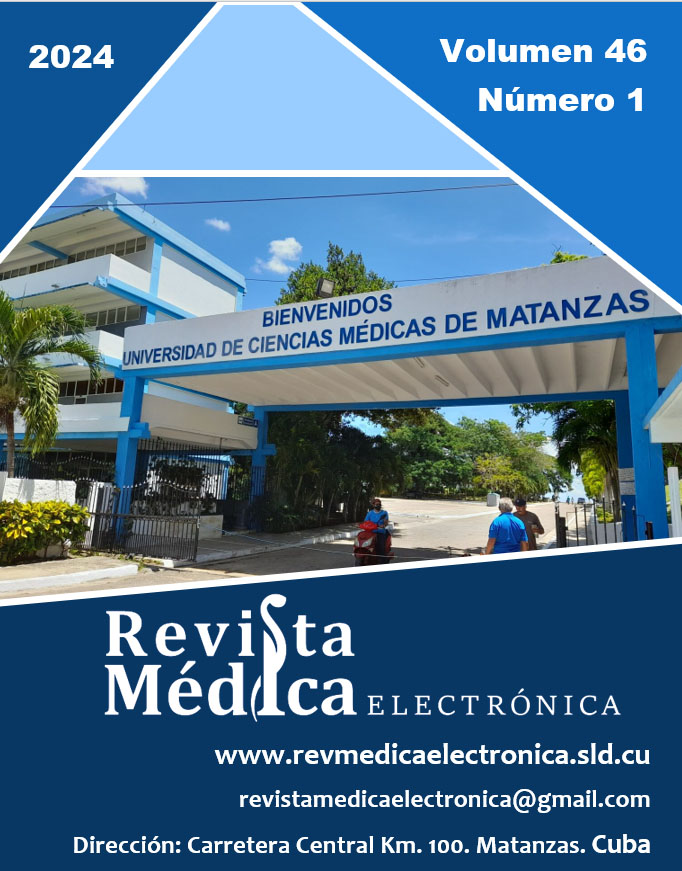Deformidad en equino del tobillo en edades pediátricas
Palabras clave:
deformidad en equino del tobillo, equino varo, equino valgo, Z-plastia del tendón de Aquiles, alargamientos del tendón de Aquiles, hemiepifisiodesisResumen
La deformidad en equino del tobillo ocurre como consecuencia de múltiples entidades. Aunque la primera línea de tratamiento es la conservadora, las modalidades quirúrgicas son necesarias en la mayoría de los enfermos pediátricos. Estas últimas son las más empleadas por zonas del complejo músculo-tendinoso, en especial los alargamientos fraccionados y en forma de Z-plastia. El objetivo de este trabajo es actualizar y brindar información sobre los distintos procedimientos quirúrgicos en la corrección de la deformidad en equino del tobillo. En la búsqueda y análisis de la información se emplearon las siguientes palabras: equinus deformity, equino varus, equino valgus; drop foot deformity y Achilles tendon Z-lengthening. A partir de la información obtenida, se realizó unala revisión bibliográfica de un total de 187 artículos publicados en las bases de datos PubMed, Hinari, SciELO, EBSCO, Scopus, Medscape y Medline, mediante el gestor de búsqueda y administrador de referencias EndNote. De ellos se utilizaron 30, 28 de los últimos cinco años. Se hace referencia a la anatomía esencial de la zona, al igual que a la prueba de Silfverskiöld. Con relación a la imagenología, se describe la técnica para calcular la distancia del tendón a alargar. Se mencionan las técnicas quirúrgicas de alargamiento fraccionado, por Z-plastia, trasposición anterior del tendón de Aquiles y la hemiepifisiodesis.
Descargas
Citas
2. Ferguson AB. Orthopaedic Surgery in Infancy and Childhood. 5th ed. London: Williams & Wilkins; 1981. p. 688-93.
3. Karol LA. Disorders of the Brain. En: Herring JA. Tachdjian's Pediatric Orthopaedics. 6th ed. Philadelphia: Elsevier; 2022. p.1420-96.
4. Volpon JB, Natale LL. Critical evaluation of the surgical techniques to correct the equinus deformity. Rev Col Bras Cir [Internet]. 2019 [citado 30/04/2023];46(1):e2054. Disponible en: https://www.scielo.br/j/rcbc/a/qnFMKmFs3czbJkyGNHkWQ6z/?lang=en
5. Canale ST, Beaty JH. Operative Pediatric Orthopaedics. St. Louis: Mosby Year Book; 1991. p. 663-6.
6. Horsch A, Petzinger L, Ghandour M, et al. Defining equinus foot in cerebral palsy. Children (Basel). 2022;9(7):956. DOI: 10.3390/children9070956.
7. Kaneuchi Y, Otoshi K, Hakozaki M, et al. Talipes equinus deformity caused by fibrous gastrocnemius muscle contracture after direct contusion in football players: report of two cases. J Foot Ankle Surg. 2020;59(4):816-20. DOI: 10.1053/j.jfas.2019.10.004.
8. Gaber K, Mir B, Shehab M, et al. Updates in the surgical management of recurrent clubfoot deformity: a scoping review. Curr Rev Musculoskelet Med. 2022;15(2):75-81. DOI: 10.1007/s12178-022-09739-6.
9. Kaiser P, Guss D. Surgical management of musculotendinous balance in the progressive collapsing foot deformity: the role of peroneal and gastrocnemius contracture. Foot Ankle Clin. 2021;26(3):559-75. DOI: 10.1016/j.fcl.2021.06.005.
10. Feraru LM, Solomon ME. Gradual correction of pediatric equinus deformity. Clin Podiatr Med Surg. 2022;39(1):143-56. DOI: 10.1016/j.cpm.2021.09.006.
11. Sees JP, Miller F. The foot in cerebral palsy. Foot Ankle Clin. 2021;26(4):639-53. DOI: 10.1016/j.fcl.2021.07.002.
12. Spence DD, Sheffer BW. Cerebral palsy. En: Azae FM, Beaty JH. Campbell's operative Orthopaedics. 14th ed. Philadelphia: Elsevier; 2021. p. 1345-9.
13. Gendy S, ElGebeily M, El-Sobky TA, et al. Current practice and preferences to management of equinus in children with ambulatory cerebral palsy: A survey of orthopedic surgeons. SICOT J. 2019;5(3). DOI: 10.1051/sicotj/2019003.
14. Ozyalvac ON, Akpinar E, Gur V, et al. A Formula to Predict the Magnitude of Achilles Tendon Lengthening Required to Correct Equinus Deformity. Med Princ Pract. 2020;29(1):75-9. DOI: 10.1159/000501603.
15. Atef A, El-Rosasy M, El-Tantawy A. Talectomy for the management of resistant talipes equinovarus deformity; does adding Ilizarov external fixator provide extra advantages? J Foot Ankle Surg. 2020;60(2):307-11. DOI: 10.1053/j.jfas.2020.08.033.
16. Matsushita T, Watanabe Y, Takenaka N, et al. Correction of equinus deformity by means of a new unconstrained ilizarov frame system. Injury. 2021;52(7):2006-9. DOI: 10.1016/j.injury.2021.02.002.
17. Tan Q, Yang G, Liu Y, et al. Retrospective case analysis of 104 cases of talipes equinus. J Enviormental Public Health. 2022;2022:1-6. DOI: 10.1155/2022/9769092.
18. Arafa OM, Alzuhair AR, Alharbi SK, et al. Surgical correction of foot equino-cavocarus deformity in Klippel-Trénaunay-Weber syndrome: a case report. J Surg Case Rep. 2021;2021(10). DOI: 10.1093/jscr/rjab434.
19. Boffeli TJ, Gorman CM. Achilles lengthening and multiple Z-plasty in parallel for correction of toe walking associated with burn scar equinus contracture. J Foot Ankle Surg. 2019;58(5):1025-9. DOI: 10.1053/j.jfas.2019.01.007.
20. Du D, Zhang C. Two-incision, wire-assisted Achilles tendon Z-lengthening: surgical technique and case report. J Foot Ankle Surg. 2019;58(3):604-8. DOI: 10.1053/j.jfas.2018.11.003.
21. Rutz E, McCarthy J, Shore BJ, et al. Indications for gastrocsoleus lengthening in ambulatory children with cerebral palsy: a Delphi consensus study. J Child Orthop. 2020;14(5):405-14. DOI: 10.1302/1863-2548.14.200145.
22. Wegner M, Koyro KI, Kosegarten L, et al. Continuous wear of night and day orthosis is a key factor for improvement of fixed equinus deformity after the transverse Vulpius procedure. Children (Basel). 2022;9(2):209. DOI: 10.3390/children9020209.
23. Sclavos N, Thomason P, Passmore E, et al. Foot drop after gastrocsoleus lengthening for equinus deformity in children with cerebral palsy. Gait Posture. 2023;100:254-60. DOI: 10.1016/j.gaitpost.2023.01.007.
24. Dabash S, Potter E, Catlett G, et al. Taylor spatial frame in treatment of equinus deformity. Strategies Trauma Limb Reconstr. 2020;15(1):28-33. DOI: 10.5005/jp-journals-10080-1452.
25. Kirienko A, Gradov L, Malagoli E, et al. Correction of a complex foot deformity with V and Y osteotomy and Ilizarov method. J Foot Ankle Surg. 2022;61(6):1209-20. DOI: 10.1053/j.jfas.2022.02.005.
26. McKeithan LJ, Whitaker AT. Foot drop, hindfoot varus and tibialis posterior tendón transfer in cerebral palsy. Orthop Clin North Am. 2022;53:311-7. DOI: 10.1016/j.ocl.2022.03.005.
27. Varghese RA, Rebello G, Shah H, et al. Biomechanical basis for treatment of pediatric foot deformities part II: pathomechanics of common foot deformities. J Pediatr Orthop Soc N Am. 2022;4(2):1-18. DOI: 10.55275/JPOSNA-2022-0038.
28. Zargarbashi R, Abdi R, Bozorgmanesh M, et al. Anterior distal hemiepiphysiodesis of tibia for treatment of recurrent equinus deformity due to flat-top talus in surgically treated clubfoot. J Foot Ankle Surg. 2020;59(2):418-22. DOI: 10.1053/j.jfas.2019.08.018.
29. Giertych B, Galli S, Halanski M, et al. Anterior hemi-epiphysiodesis of the distal tibia for residual equinus deformity in children with clubfeet. J Pediatr Orthop Soc N Am. 2022;4(1):1-11. DOI: 10.55275/JPOSNA-2022-0004.
30. Tabaie SA, Videckis AJ. Achilles lengthening. J Pediatr Orthop Soc N Am. 2021;3(3). DOI: 10.55275/JPOSNA-2021-310.
Publicado
Cómo citar
Número
Sección
Licencia
La misma permite:
• Copiar y redistribuir el material publicado en cualquier medio o formato.
• Adaptar el contenido.
Esto se realizará bajo los siguientes términos:
• Atribuir los créditos de los autores e indicar si se realizaron cambios, en cuyo caso debe ser de forma razonable.
• Uso no comercial.
• Reconocer la revista donde se publica.
Se mantienen los derechos de autoría de cada artículo, sin restricciones.







